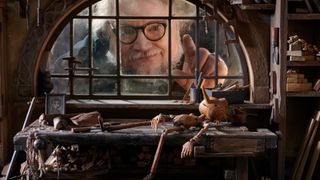While Guillermo del Toro's Pinocchio may be a familiar story, it does not retread familiar ground. The filmmaker wanted to elevate the story beyond the comforting fable familiar to many. As a result, unlike the Robert Zemeckis-directed live-action/ animation hybrid Pinocchio released on Disney Plus, the primary target is not the under-10s.
"It was not made for kids," del Toro tells tells SFX in the new issue of the magazine, featuring Violent Night on the cover. "Kids can watch it. But it’s not made for kids. It’s made for us."
The production of Pinnochio, which uses physical puppets rather than CGI creations, was hamstrung by Covid, colliding it with the shoot for del Toro’s recent remake of Nightmare Alley. "We had the perfect plan for Nightmare Alley to ramp down and Pinocchio would ramp up," he says. "And lo and behold, Covid came and changed our plans. But what was great is every day, Nightmare Alley would start or end with Pinocchio: we would be on Zoom with the animators.”
The two films influenced each other, especially with production designer Guy Davis working across both. Like Nightmare Alley, Pinocchio features a crucial carnival scene, where Count Volpe (Christoph Waltz) and his monkey Sprezzatura (Cate Blanchett, believe it or not) prey on the boy.
"There’s actually a shot that is a [nod to] Nightmare Alley when Sprezzatura comes into the carnival," says del Toro. "I made it a point to have a rolling wheel of fortune in front of him, which is the way the Major [played by Mark Povinelli] enters the carnival in Nightmare Alley. And thematically, both deal with truths and lies."
Despite such issues, del Toro says he had the full backing of Netflix, who also supported his earlier animated series Trollhunters. He was also adamant that the film would not be compromised by the committee decision-making typical of studios.
"I made it a point to guarantee to the entire crew and cast that it would not be an industrial product, that we would not test it and hone it for an audience," he says. "That we would hone it for ourselves."
- Not a subscriber to SFX? Then head on over here to get the latest issues sent directly to your home/device
That's just a snippet of the longer read with del Toro, available in the Violent Night issue of SFX Magazine, available on now! For even more from SFX, sign up to the newsletter, sending all the latest exclusives straight to your inbox.

